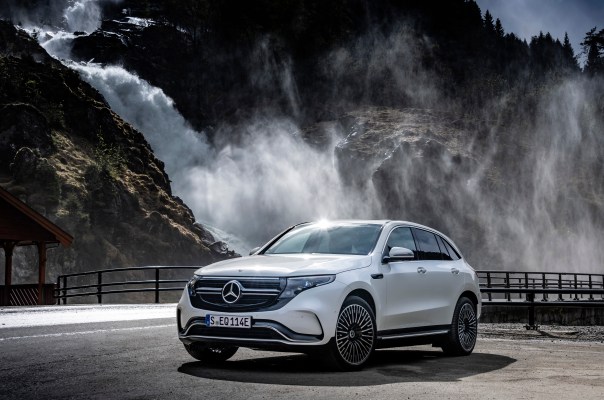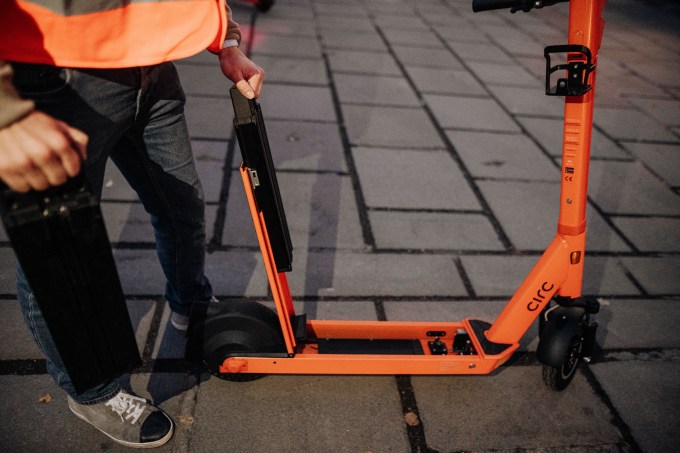Technology

The Mercedes-Benz EQC 400 4MATIC, the German automakerfirst all-electric vehicle under its new EQ brand, will start at $67,900 when it arrives in the U.S. early next year.
Mercedes-Benz announced the price of the EQC 400 Wednesday at the LA Auto Show. The price, which doesn&t account for the $7,500 federal tax credit, is notable because itbelow competitors like the Jaguar I-Pace, Audi e-tron and Tesla Model X.
Itbeen a year sinceMercedes-Benz unveiled the EQC, an all-electric SUV that kicked off the automakerplans to invest more than $12 billion to produce a line of battery-powered models under its new EQ brand. And in March, TechCrunch got a brief ride in the SUV in Austin during SXSW. In short, information about the vehicle has been out there. But the price has not.
The Mercedes EQC has a new drive system with compact dual electric drivetrains at each axle, which together generate 402 horsepower and 561 pound-feet of torque. The EQC can travel from 0 to 60 miles per hour in 4.8 seconds.
Mercedes has configured the vehicle motors to handle different aspects of the driving.The front electric motor is optimized for efficiency in the low to medium load range, while the rear motor is designed to create a sporty driving experience.
The vehicle80 kilowatt-hour battery has an estimated range of around 200 miles, Mercedes-Benz has said in the past. The company didn&t provide updated numbers. The battery has standard DC fast-charging that can reach an 80% charge in 40 minutes.
The EQC will come standard with the companynew MBUX infotainment system, which is already in the A-Class. The infotainment system has put an emphasis on voice assistant technology and navigation, which will be critical for new EV converts worried about locating charging stations. EQ-optimized navigation, driving modes, charging current and departure time also can be controlled and set via MBUX, the company said.
MBUX will recommend the shortest amount of time needed to get to a destination and uses online services to find available DC fast charging stations to use if the operating range is insufficient. Mercedes-Benz customers can also find charging stations via the Mercedes me Charge card, the Mercedes me App or directly from the car.
The onboard charger makes the most from available external power, with the battery able to recharge from 10% to 80% in just 40 minutes.
The EQC will be available in three tiers at launch: progressive, premium and advanced. The progressive and premium tiers will offer two curated paint and upholstery options, while three selections will be available for the more expensive advanced tier.
The entry-level progressive trim will come standard with MBUX, two 10.25-inch digital displays with touchscreen, advanced driver assistance system features like active brake assist with autonomous emergency braking and LED headlamps with adaptive high-beam assist.
Production of the EQC started this year at the Mercedes-Benz plant in Bremen.
- Details
- Category: Technology
Read more: Mercedes prices its all-electric EQC SUV at $67,900
Write comment (92 Comments)
Apple just released the iPhone 11 Probattery case and it comes with a surprise: a button for the camera. This is a minor, but welcomed, addition to an otherwise standard battery case.
The button is clever. Itlocated on the bottom half of the case and is not a soft button that presses something on the phone. This button is exclusive to this case and when pressed, launches the iPhoneCamera app even if the iPhone is locked. A quick press takes a photo and a longer press takes a QuickTake video.
The $129.00 case is available for both iPhone Pro 11 and iPhone 11 and has other features too. Itcompatible with Qi-certified chargers and works with USB-PD-compatible chargers to pump power into the battery at a faster rate. Apple says when the case is fully charged, it will provide 50% longer battery life.
This is the first time Apple has added a shortcut of sorts to the camera app. On most Android phones, a double press of the power button launches the camera app. Ithandy, and while this button is exclusive to a case, ita step in the right direction. Herehoping that Apple figures out how to add this button to non-battery cases.
- Details
- Category: Technology
Read more: Apple’s iPhone 11 Pro battery case sports a new camera button
Write comment (90 Comments)After a year of testing out environmental technologies for a private company, co-founder Patricia Ayma developed a process for bioplastic production using bacteria. The system turns organic matter, such as food waste, into a product that can be used as a biodegradable alternative to single-use plastics. &I realized that it was a simple technology for taking to society, that will benefit everyone,& she tells us.
The biotech startup began its pilot phase near Barcelona, at a BonArea supermarket plant, where they were able to develop and test the technology on an industrial scale with a potential customer. Ayma plans to push the innovation toward two sectors: Organic waste producers that want to shrink waste management costs and companies interested in purchasing the bioplastics for various applications.
The team recently closed an investment round of more than €2 million, which will allow them to open a 33,000-square-foot plant to start production on the VE-box: A portable waste management container that will transform organic waste into biodegradable plastics.
- Details
- Category: Technology
Read more: VEnvirotech transforms organic waste into bioplastics
Write comment (91 Comments)
At its Cloud Next event in London, Google Cloud CEO Thomas Kurian today announced that Smart Compose, the AI-powered feature that currently tries to complete phrases and sentences for you in Gmail, is also coming to G SuiteGoogle Docs soon. For now, though, your G Suite admin has to sign up for the beta to try it and itonly available in English.
Google says in total, Smart Compose in Gmail already saves people from typing about 2 billion characters per week. At least in my own experience, it also works surprisingly well and has only gotten better since launch (as one would expect from a product that learns from the individual and collective behavior of its users). It remains to be seen how well this same technique works for longer texts, but even longer documents are often quite formulaic, so the algorithm should still work quite well there, too.
Google first announced Smart Compose in May 2018, as part of its I/O developer conference. It builds upon the same machine learning technology Google developed for its Smart Reply feature. The company then rolled out Smart Compose to all G Suite and private Gmail users, starting in July 2018, and later added support for mobile, too.
- Details
- Category: Technology
Read more: Smart Compose is coming to Google Docs
Write comment (90 Comments)
TechCrunch covers a lot of bases in the tech startup world, but none is more important than supporting founders — especially early-stage founders. Thatwhat our new event series, TechCrunch Early Stage, is all about.
These single-day events debuting next year will be highly interactive opportunities for founders to tap experts in the core startup disciplines, starting with early-stage investors (lots of investors), legal whizzes, growth gurus, product-market fit wallahs, tech stack experts, recruiting aces and much more, including workshops on pitch breakdowns.
TechCrunchgoal is to provide founders with insights and new relationships on par with what an accelerator experience provides, only in a single day, and with a much greater variety of experts and investors.
TC Early Stage is an outgrowth of Extra Crunch, TechCrunchsubscription-based editorial offering that focuses on deep analysis and advice around the big topics facing founders. In October this year at Disrupt SF, we brought Extra Crunch to life on its own stage and featured experts on dozens of topics, including:
- How to Raise My First Dollars (Russ Heddleston, DocSend, Charles Hudson, Precursor Ventures and Annie Kadavy, Redpoint Ventures)
- How to Hire at Breakneck Speed (Scott Cutler, StockX, Harjeet Taggar, TripleByte and Liz Wessel, WayUp)
- How to Evaluate Talent and Make Decisions (Ray Dalio, Bridgewater Capital)
- How to Get into Y Combinator (Michael Siebel, Y Combinator)
- How to Decide Between Bootstrapping and Raising Venture (Ben Chestnut, Mailchimp and Kathryn Petralia, Kabbage)
The sessions were mobbed. The TechCrunch team knows a winner when they see one, and the result is this new event series. The first of three TC Early Stage events next year will be in San Francisco on April 28, with one in Paris on October 28 and another in New York City (date TBA).
TC Early Stage is designed for founders who are in their early innings, anywhere from pre-seed through Series A, when entrepreneurs need all the guidance they can get. With that in mind, the eventheart is dozens of breakout sessions run by experts and curated by TechCrunch editors. The breakouts will be long on attendee questions and conversation, and the event is structured so that attendees can easily get to six to eight different breakouts over the course of the day. In addition, TechCrunch editors will hold a handful of interviews on a main stage with notable founders and investors in time slots that will not conflict with the breakouts.
Here is a sampling of the types of breakout sessions TechCrunch Early Stage will feature:
- Raising a first seed round
- Landing a Series A
- Raising early-stage investment for a SaaS company (also consumer and other major categories)
- Considering your first term sheet
- Growing users fast
- Recruiting a fabulous team
- Building a tech stack (you won&t regret)
Between sessions, attendees also can meet the experts running the breakout sessions, as well as each other, via CrunchMatch, TechCrunchevent networking platform that connects like-minded attendees and arranges a meeting time and place.
The TechCrunch team is already busy building an all-star lineup for experts for the breakout sessions and memorable interviews for the main stage. The response from the expert community around TechCrunch has been resoundingly clear. Everyone sees the need — the deeper education of early-stage founders — and they love the TC Early Stage format — a single day, highly interactive event that brings together early-stage founders with an unprecedented collection of experts from across the startup ecosystem.
Tickets for the San Francisco event are available now, so jump in and grab yours to secure your seat while they last.
Not an early-stage founder? Thatokay, too. Later-stage founders, investors or just general startup enthusiasts are welcome to attend. A limited number of &Innovator passes& are available for folks who are not early-stage founders.
Partners are also very welcome! The event has many sponsorship opportunities, including breakout sessions. Contact the sales team to learn more by filling out this form.
- Details
- Category: Technology
Read more: Announcing TechCrunch Early Stage, a new event series all about founders
Write comment (93 Comments)Circ, the Berlin-based e-scooter rentals — or so-called micromobility — company founded by Lukasz Gadowski of Delivery Hero fame, has made a number of layoffs, TechCrunch has learned.
This has seen a reduction in headcount in its HQ and other regional operations. The exact number isn&t clear, although one source placed it at around 50 people, or less than 10% of employees.
Confirming the restructuring, Circ issued the following statement, citing the move to swappable batteries and a shift of focus to &efficiency and ops excellence&:
After fast growth in the initial stage now we focus on efficiency and ops excellence, including switching our operations mode to swappable battery scooters, [we] just introduced the Circ &KAISER& vehicle in a few German cities. Apart from being more cost efficient that is also more sustainable (cargo bikes instead of vans).
I managed to get Gadowski on a call and he added some further context to the layoffs, citing three reasons behind the decision to reduce headcount: seasonality, operational learnings and indeed the move to e-scooters with swappable batteries.
&Ita seasonal business, we have less riders in the winter than summer,& explained the Circ founder. &In winter you can expect less than 50% of your summer rides with the current micromobility devices. That may change in the future.&
With regards to operational learnings, Gadowski says the company needed to learn how to operate a micromobility service across many markets simultaneously. &Basically figure out how to be more efficient, how to run a micromobility operation; itnot optimised yet and we learned over the summer.&
He also conceded that, within the micromobility space more generally, there had been something of a land grab strategy that is now perhaps inevitably shifting toward greater emphasis on capital efficiency. &When we started this there was a focus on time to market but now it is not about time to market but efficiency,& he tells me.
Finally, Gadowski says the move to swappable battery technology means that Circ can run more efficiently and therefore also requires fewer people.
&What happens at the moment is we have warehouses where we store the scooters, maintain them and charge the batteries. Vans bring them into the city hotspots, the user rides them, then vans pick them up again where they are maintained or batteries charged. And now this changes to swappable batteries operations in which the vehicles are equipped with batteries that are swappable so you charge only the battery in the warehouse… and mechanics do light maintenance in-field. This requires less people because it is more operations efficient.&

The Circ KAISER, equipped with a swappable battery system
Meanwhile, Circ shared some updated metrics with TechCrunch. The company says it has enabled approximately 10 million rides to date and has 3 million registered customers. It operates in more than 40 cities across 14 European countries, in addition to United Arab Emirates.
I&m also told that this year Circ has seen &positive unit economics& in cities in about one-third of its countries (five out of 14). &In 2020 we expect to be unit economic profitable across the group,& a spokesperson tells TechCrunch.
Circ — then called Flash — raised €55 million in Series A funding in January, with Target Global leading the round via its mobility fund.
- Details
- Category: Technology
Read more: Circ, the Berlin-based e-scooter company, makes layoffs following ‘operational learnings’
Write comment (93 Comments)Page 309 of 5614

 16
16